Summary of climate disasters on the planet from June 3 to 10, 2025
Across the globe, events are occurring that would have been unimaginable just a short time ago. Seismic activity continues to intensify, and Russia is among the countries where natural disasters are escalating with exceptional speed.
In this episode, you will learn about the natural disasters of the past week, from June 4 to June 10, 2025, which have brought us even closer to a critical threshold. You will also discover what actions each of us can take to change the situation—while this is still possible.
Seismic Activity
On June 6 at 13:15 LT, residents of northern Chile experienced a powerful earthquake with a magnitude of 6.4. The epicenter was located in the Atacama Desert region, near the Pacific coast, 54 km (33.5 mi) south of the city of Diego de Almagro. The hypocenter lay at a depth of 65 km (40.4 mi).
During the shaking, people fled into the streets in panic. Although no official damage reports were released, video footage showed partial collapse of building façades. Landslides occurred in some areas, and cracks appeared in the roads. About 23,000 people were temporarily left without electricity.
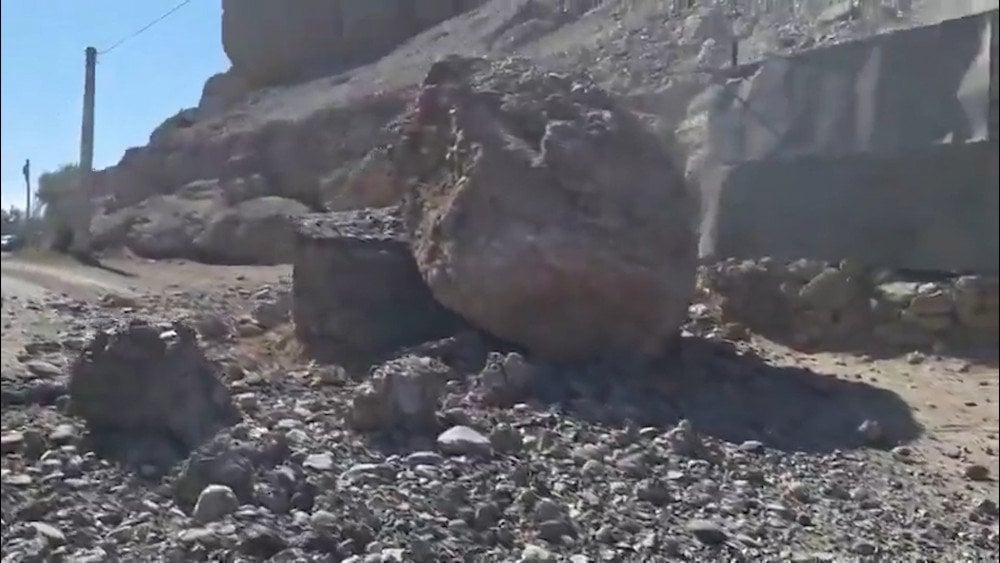
A magnitude 6.4 earthquake triggered landslides in Chile
On June 3 at 02:17 LT, an M5.8 earthquake occurred in the Mediterranean Sea, 10.43 km (6.5 mi) off the coast of Marmaris, Muğla Province, Turkey. It also shook the Greek island of Rhodes and the southwestern coast of Turkey. The hypocenter was at a depth of 67.91 km (42.2 mi).
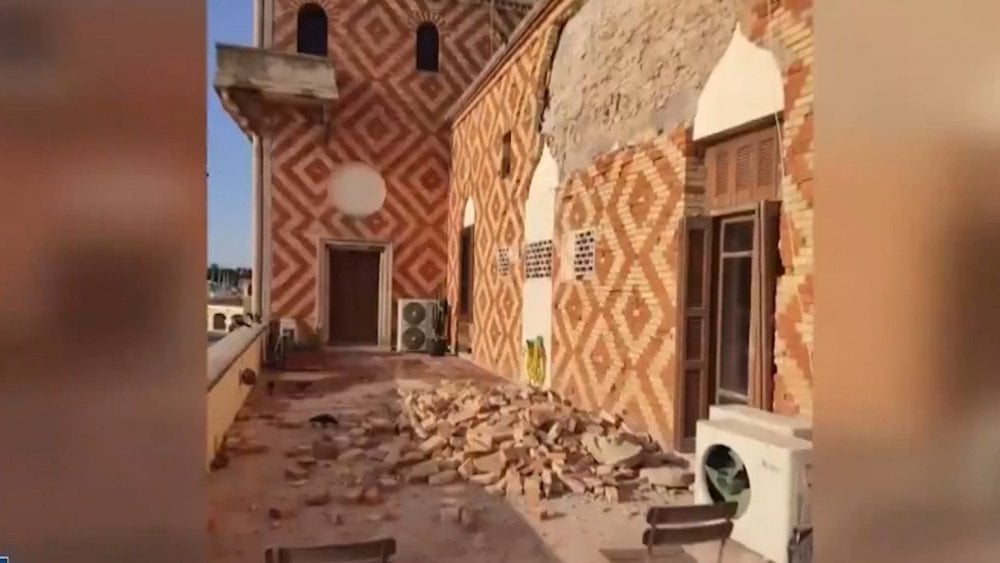
Damaged buildings after the 5.8M earthquake on Rhodes Island, Greece
Local residents and numerous tourists, awakened by the intense shaking, rushed out of homes and hotels; some spent the night outdoors.
In Turkey’s Muğla Province, 75 people were injured—most of them while jumping out of windows.
A 14-year-old girl suffered a severe panic attack during the earthquake. Unfortunately, she passed away despite doctors' efforts.
On the morning of June 8 at 08:08 LT, a destructive earthquake with a magnitude of 6.5 struck central Colombia. The hypocenter was 10 km (6.2 mi) deep.
The quake was felt in 20 out of the country’s 32 departments.
The most severe aftermath was recorded in the small town of Paratebueno, in Cundinamarca Department, located just 16 km (9.9 mi) from the epicenter. There, 250 residential buildings and a school were almost completely destroyed. Fortunately, no children were harmed, as the quake struck on a Sunday. Electricity and water supply in the town were cut off.
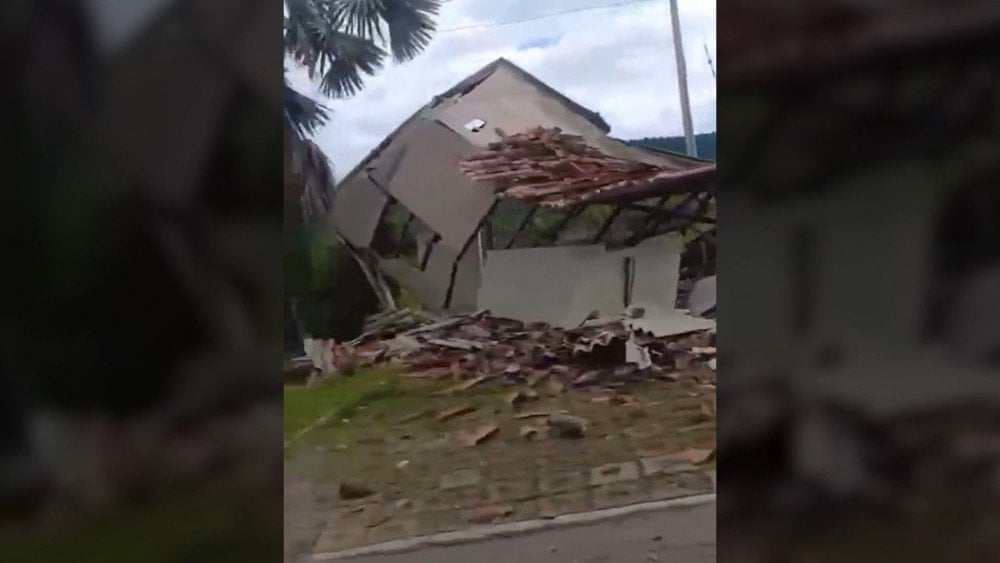
Aftermath of the M6.5 earthquake in Colombia
In the neighboring municipality of Medina, 100 residential buildings were reported damaged.
Numerous churches in the region were also affected, while morning mass was underway and thousands of parishioners were inside.
In the country’s capital, Bogotá, this earthquake became one of the strongest and longest in recent memory. Sirens wailed in residential neighborhoods, and residents ran into the streets in panic. The facades of buildings partially collapsed, electricity was cut off throughout the city, and a landslide occurred in one of the areas.
Cracks appeared in several roads, including on the national highway between Villavicencio and Jopal.

Cracks on roads caused by the M6.5 earthquake in Colombia
As a result of the earthquake, 20 people were injured.
As of June 11, more than 250 aftershocks had been recorded, with magnitudes up to 4.8.
In the area of the Italian supervolcano Campi Flegrei, seismic activity resumed at the beginning of June. Between June 2 and 8, a total of 148 earthquakes were recorded, with magnitudes up to 3.2. Eighty-six of them occurred during three seismic swarms.
On June 8 at 07:39 LT, a strong earthquake with a magnitude of 5.3 struck in the waters of the Arctic Ocean, 587 km (365 mi) north of the Russian Franz Josef Land archipelago.
It is worth noting that earthquakes of such high magnitude are extremely rare in this region. According to the U.S. Geological Survey (USGS), only two quakes with a magnitude of 5.1 have ever been recorded here throughout the entire period of instrumental monitoring.
Germany
On June 4, a powerful storm with thunderstorms and hail hit southern and western Germany. Wind gusts in some areas exceeded 100 km/h (62 mph). The storm brought down trees, flooded basements, and caused numerous emergency incidents.
In the city of Ulm in Baden-Württemberg, eyewitnesses reported a sudden loud bang, after which the wind tore the roofs off several houses and severely damaged parked cars.
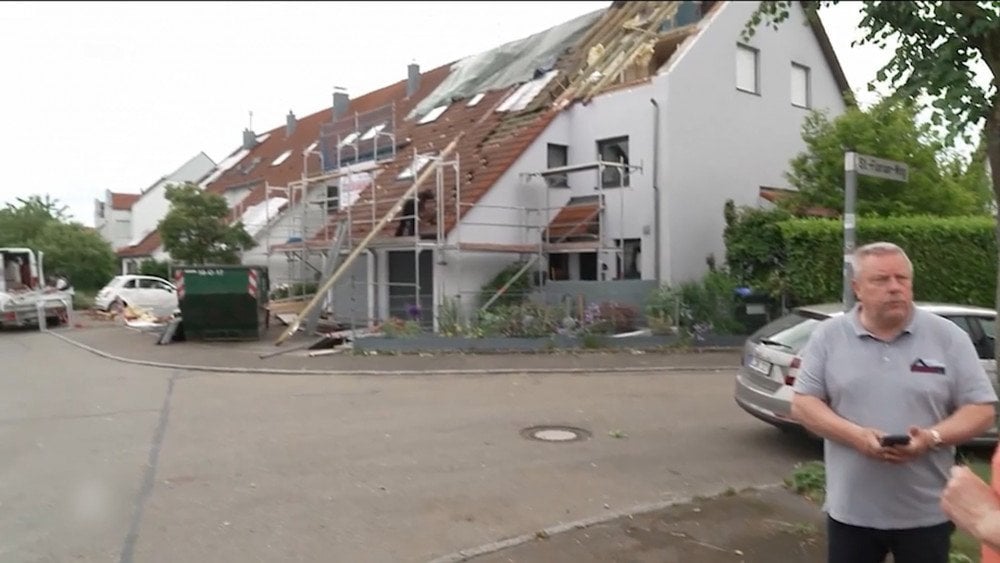
Powerful storm damaged a house roof, Ulm, Baden-Württemberg, Germany
In Bavaria, in the municipality of Schöngaising, Fürstenfeldbruck district, large hail up to 7 cm (2.75 in) in diameter fell, causing damage to buildings and vehicles.
A tragic incident occurred in the town of Wilnsdorf, North Rhine-Westphalia, where a woman was struck by lightning. A helicopter with a medical team arrived quickly, but she could not be saved.
During the storm, a Ryanair passenger plane flying from Berlin to Milan encountered severe turbulence. Eight people, including one crew member, were injured.
The aircraft made an emergency landing at Memmingen Airport, where several of the injured were hospitalized.
Poland
Starting June 4, a wave of powerful storms swept across Poland. Wind gusts reached up to 120 km/h (75 mph), uprooting trees—thousands of them fell across the country.
A total of 156 buildings were damaged. Torrential rains turned roads into rushing streams, and in several regions, large hail up to 5.5 cm (2.2 in) in diameter was reported.
30,000 people in the south of the country were left without electricity.
In some parts of Lower Silesian Voivodeship, 25 mm (0.98 in) of rain fell within just 10 minutes.
Farmers in the villages of Żurawina and Węglewo experienced a real tragedy: heavy rain and hail turned their fields into lakes and destroyed crops that were ready for harvest.

Aftermath of heavy rain and hail in Poland: flooded fields and destroyed harvest
In Masovian Voivodeship, in Drobin, Płock County, strong winds completely tore the roofs off 10 buildings and partially damaged another 29.
A tornado struck the Przasnysz municipality, toppling trees and blocking a national road.
Lesser Poland Voivodeship was also seriously affected. In the city of Kraków, a sudden hailstorm sent people fleeing in panic from streets and parks in search of shelter. Cars pulled over to the roadside, unable to drive due to near-zero visibility.
In the city of Trzebinia, strong winds damaged many buildings, including a historic basilica, from which about 400 m² (4,300 ft²) of roof was torn off, causing partial flooding inside.
Unfortunately, the storm claimed one life; another person was injured and hospitalized.

After the severe storm in Poland, the ground was completely covered in hail
Belarus
On June 5, Belarus was also affected by a powerful storm. The most severe impacts were felt in the Minsk, Grodno, and Mogilev regions.
Heavy rains flooded streets and building basements. Wind gusts tore off roofs, and fallen trees damaged vehicles. The region experienced widespread power outages.
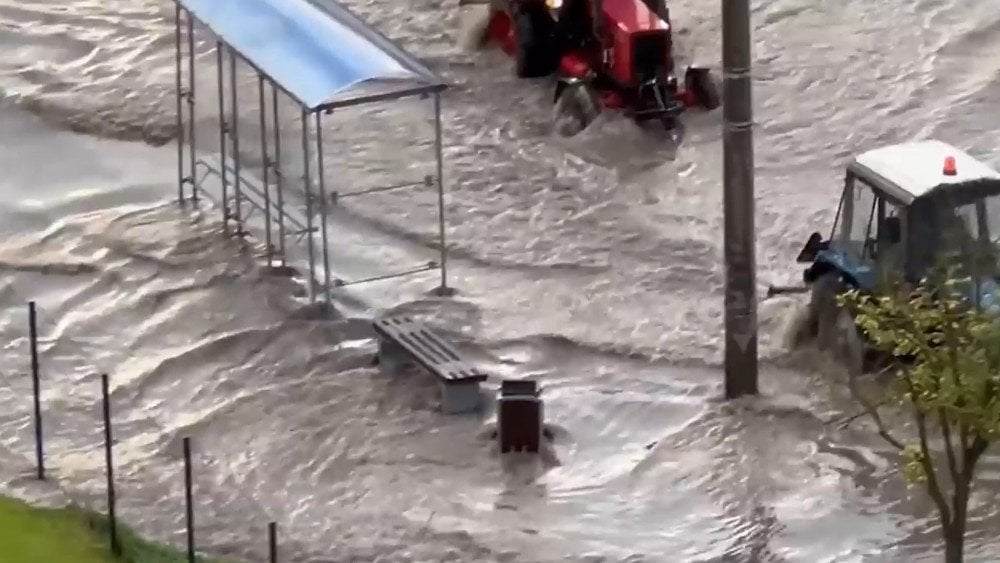
Heavy rain flooded city streets, Belarus
The storm also reached the capital, Minsk, where water entered several large shopping centers, underground parking lots, and a number of residential buildings.
In the Mogilev region, two private houses caught fire due to lightning strikes.
Lithuania
On June 5, a powerful tornado swept through southern Lithuania, in the Čepkeliai Nature Reserve near the village of Musteika, close to the Belarusian border.

Powerful tornado in Lithuania
The twister traveled several kilometers, snapping large trees like matchsticks. Lithuanian border guards found themselves directly in the path of the approaching funnel—they had to urgently abandon their posts and retreat to avoid falling trees.
Fortunately, no one was injured.
Russia
A wave of natural disasters across Russia continues to intensify.
On June 6, a powerful storm struck eastern Orenburg Oblast. In Kuvandyksky District, hurricane-force winds knocked down trees, blocking roads. In some places, hail fell so intensely that highways became coated in a sheet of ice within minutes. In the Adaevskaya Mountain area, traffic came to a complete standstill.
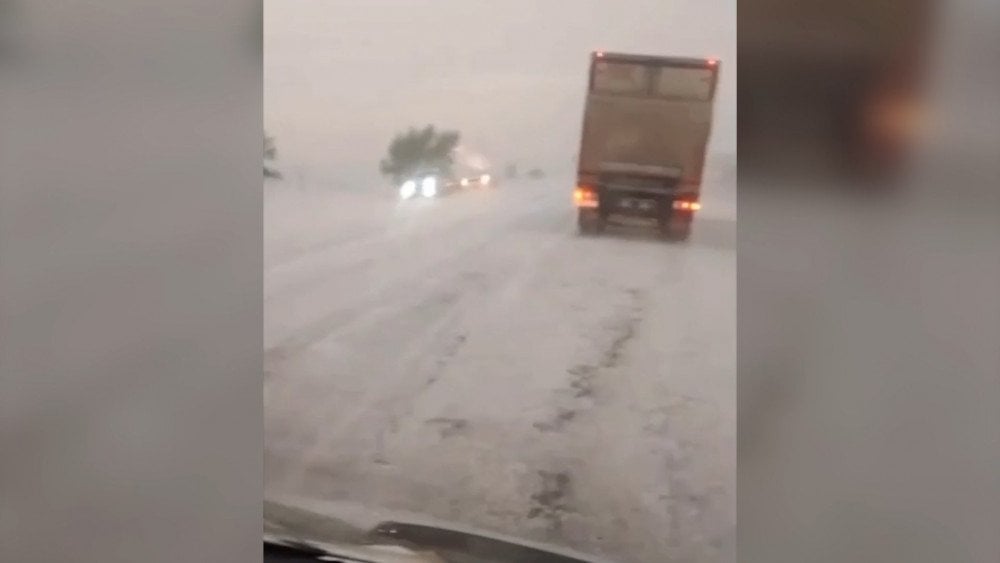
Heavy hail created dangerous road conditions, Orenburg Oblast, Russia
During the height of the night thunderstorm, lightning struck a residential building and ignited a fire—fortunately, no one was injured.
In western Russia, in Zheleznogorsk, Kursk Oblast, a thunderstorm with hail up to 2 cm (0.8 in) and hurricane-force winds toppled around 500 trees, damaged dozens of vehicles, and brought down power lines.
On June 7, severe weather reached northern districts of Moscow Oblast. The cities of Mytishchi, Korolyov, Pushkino, and Shchyolkovo were hit by hail, heavy rain, and squally winds.
In Kolomna, a tree fell on a young woman seeking shelter from the storm; she was hospitalized with injuries.
On June 8, Moscow was overwhelmed by torrential rain. Traffic collapsed across the city. At the Komsomolskaya metro station (Sokolnicheskaya Line), water was pouring from the ceiling into the station vestibule.
A maintenance worker servicing a storm drain was swept into the Chertanovka River collector by a powerful water current. Thanks to coworkers and bystanders who held onto him until emergency services arrived, he was rescued.
At Vnukovo Airport, squally winds with gusts up to 25 m/s (56 mph) tore off part of the terminal roof, leading to flooding in the building.

Strong wind with heavy rain damaged the terminal roof at Vnukovo Airport, leading to flooding, Moscow Oblast, Russia
In Moscow Oblast, the cities of Naro-Fominsk and Aprelevka were hit by large hail.
In Leninsky Urban District, at the Sloboda beach, lightning struck a gazebo with people inside. A woman suffered burns and was hospitalized.
On June 8, residents of Yaroslavl Oblast witnessed a rare event for the region—a massive tornado passed near the village of Kunachevo in Uglichsky District, damaging a section of young forest.
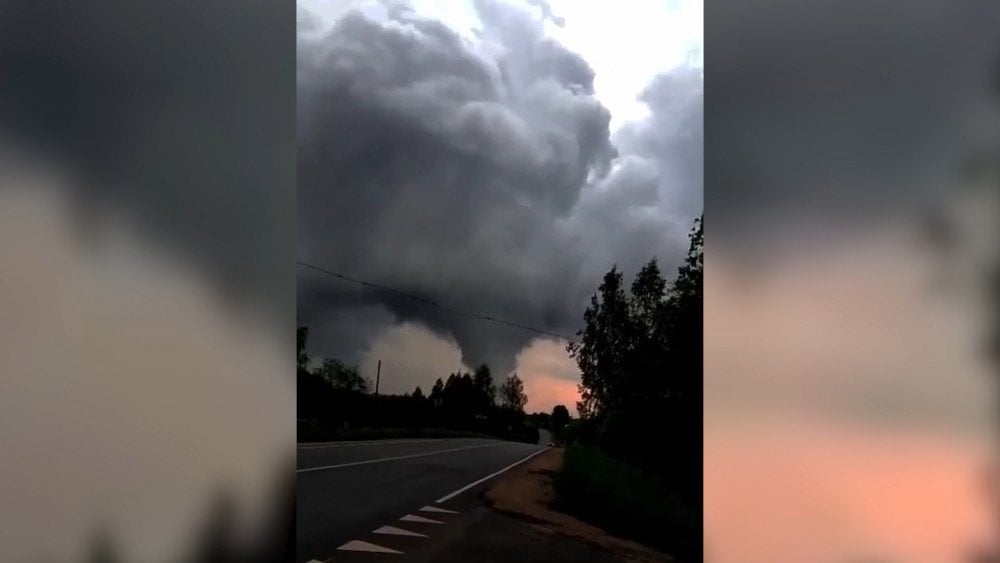
Rare natural event—tornado in Yaroslavl Oblast, Russia
The next day, a powerful thunderstorm front swept across the region. It brought heavy rain, hail, and wind gusts over 20 m/s (45 mph), which tore off roofs, toppled trees, and left people without electricity. The hardest hit areas were Yaroslavsky and Nekrasovsky districts.
On June 8 in Kemerovo Oblast, enormous hailstones the size of chicken eggs fell. In the village of Terentyevskoye, residents observed hail of unusual shapes—with sharp spikes. The storm damaged vehicles and destroyed crops.

Large hail of unusual shape fell in Kemerovo Oblast, Russia
Prokopyevsky and Novokuznetsky districts were hit hardest.
Squally winds snapped power lines. Fallen trees blocked roads, stranding dozens of vehicles in traffic.
On the evening of June 8, a torrential rainstorm hit the capital of Altai Krai, Barnaul, and continued until the next morning. Overnight on June 9, Barnaul received 60 mm (2.36 in) of rainfall, while the average monthly norm for June is 54 mm (2.13 in).
Streets were submerged—cars were literally floating through the roads. Malfunctioning traffic lights worsened the chaos and caused massive congestion.
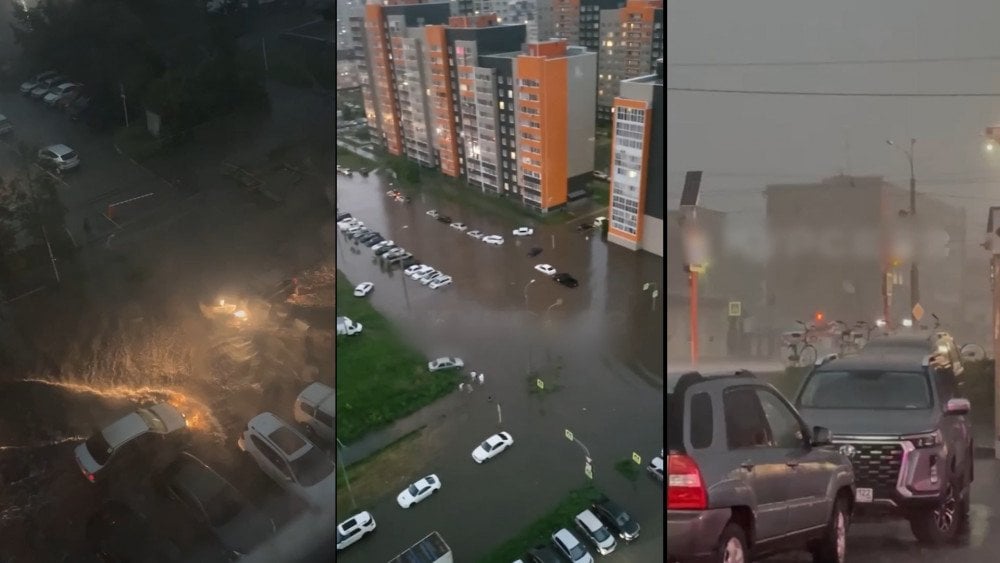
Heavy rain in Barnaul: streets flooded, traffic paralyzed, Altai Krai, Russia
Residential buildings, administrative offices, and shopping centers were flooded. Water also entered public transport vehicles.
In the village of Volchikha in Altai Krai, wind partially tore the roof off a store—a girl was injured and hospitalized. In the city of Aleysk, a portion of a two-story, 16-apartment residential building collapsed due to heavy rain. Residents were temporarily evacuated.
On the evening of June 9, a storm swept over Syktyvkar, the capital of the Komi Republic. Torrential rain flooded the city streets, while the sky was illuminated for hours by continuous lightning. By June 10, the city had received 42 mm (1.65 in) of rain in just five hours, compared to the June average monthly rainfall of 71 mm (2.8 in). Such intense precipitation and electrical activity are extremely unusual for this northern city.
On June 10 in Kirov Oblast, in the villages of Smetanino and Kugusherga, hailstones of an extraordinary size for the region—up to 8 cm (3.15 in)—were recorded.
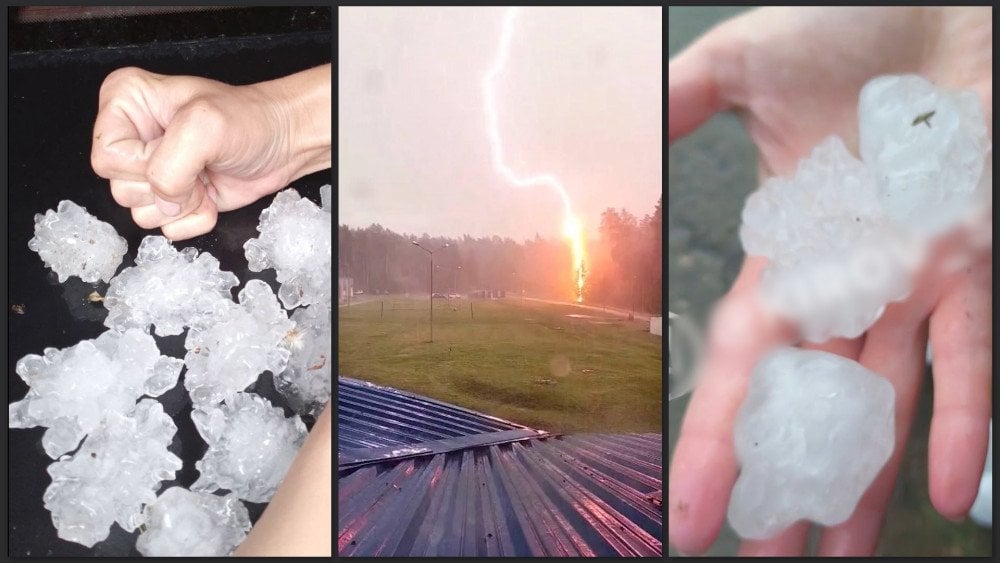
Anomalously large hail fell in Kirov Oblast, Russia
Why is it crucial not just to read this summary but to share the information?
Because disasters are escalating, and humanity still does nothing to stop the impending catastrophe. Yet, a solution exists. For years, those who have spoken out about it have gone unheard. And those who do hear often remain silent—believing they are powerless, that their voice holds no weight.
But that’s not true. Words carry power. They are at the root where everything begins: awareness, choice, and action. Words deliver information, and without information, there is no understanding, no solutions, and no plan.
When we stay silent, we leave others in the dark, which means no one knows what to do or where to go. Your silence means that you agree to the destruction of the world we live in.
But if each of us takes a step—speaks the truth, shares, and explains—we can change everything.
Just speak out. Share what you’ve learned. One post, one conversation, or one message—that is already action.
Every word matters. The key is to keep going and never give up. And together, we can succeed!
Watch the video version of this article here:
Leave a comment